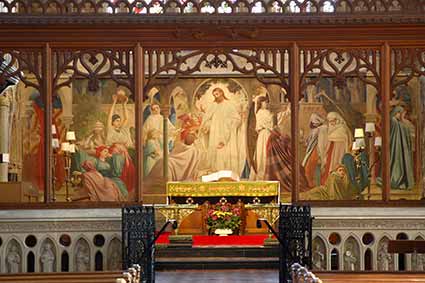Lyndhurst parish church - the current church of St. Michael and All Angels

Situated at the top of the High Street, Lyndhurst Parish Church is dedicated to St. Michael and All Angels. For a village of modest size, it’s an incredibly imposing, Gothic, primarily red-brick structure with towering 160 feet high spire that can be seen for miles around.
Constructed between 1858-69, the Parish Church was designed by William White, and is well-known for its fresco by Lord Frederick Leighton showing the parable of the Wise and Foolish Virgins, with biblical characters said to be modelled on local people.
Fine Pre-Raphaelite windows designed by William Morris, Edward Burne-Jones and Charles Kempe are also distinctive. The west window is by Kempe. His signature, a wheatsheaf taken from the family coat of arms, can be seen in a triangular window below the rose.
The New Forest Parishes of Lyndhurst, Minstead and Emery Down catch well the mood of the building: ‘It is Gothic in its ethos but uses modern materials reflecting both the theology and ecclesiology of much Victorian thought. The vision was to express something of the ancient and eternal from the Kingdom of God in the contemporary materials of the day - ancient and modern.’
Evidence of Lyndhurst’s earlier Parish Church can be seen within the present building, for a number of memorial tablets were taken forward, including one designed by John Flaxman, R.A. commemorating the life of Sir Charles Philip Jennings, Bart, who lived at nearby Foxlease, and others connected with past owners of Cuffnells and Northerwood House.
The grave of Alice Liddell, who inspired Lewis Carroll’s Alice in Wonderland,attracts many visitors, although the grave inscription refers to ‘Mrs. Reginald Hargreaves’, Alice’s married name.
By 1884-85 the Parish Church graveyard was full, and the cemetery on nearby Whitemoor came into use. Here, just inside the main gate, is the tomb of John Wise, faithful mid-19th century chronicler of the Forest scene.
Find out more about the previous parish church building:
References:
The New Forest Parishes of Lyndhurst, Minstead and Emery Down
Lyndhurst Historical Society publications: Roy Jackman
More links
Other related links
Search this site

Sadly, 58 animals were killed - 35 ponies, 13 cows, 8 donkeys and 2 sheep, whilst a further 32 were injured - 3 pigs, 9 donkeys, 11 cows and 9 ponies.
(Forty-three accidents occurred in daylight, 15 at twilight and 101 in the dark. Twenty-seven accidents were not reported by the driver involved).
Here's just one horrific example - Three donkeys killed in collision with van at notorious New Forest blackspot (Advertiser and Times)

